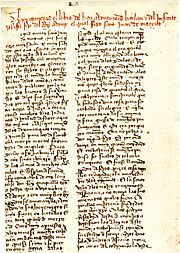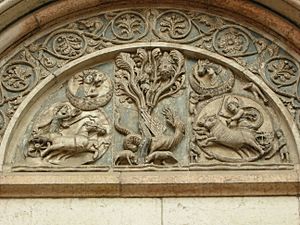Barlaam and Josaphat facts for kids
Barlaam and Josaphat, also known as Bilawhar and Budhasaf, are famous legendary Christian saints. Their story is based on the life of the Gautama Buddha. It tells how Prince Josaphat became a Christian.
The legend says that an Indian king was against the Christian Church in his land. Astrologers told him that his own son, Josaphat, would one day become a Christian. To stop this, the king kept young Prince Josaphat locked away. However, Josaphat still met a wise hermit named Saint Barlaam and chose to become a Christian.
After many challenges, the prince's father also accepted the Christian faith. He gave his throne to Josaphat and went to live in the desert as a hermit. Josaphat later gave up his own throne and went to live a quiet life with his old teacher, Barlaam.
How the Story Began
The story of Barlaam and Josaphat is a Christian version of the life of Siddhartha Gautama, who became the Buddha. This tale comes from an old Sanskrit Mahayana Buddhist text, written between the 2nd and 4th centuries.
It then traveled through different cultures. It was first a Manichaean story, then an Arabic book called Kitāb Bilawhar wa-Būd̠āsaf. This book was popular in Baghdad in the 8th century. From there, it reached Christian groups in the Middle East before becoming known in Europe.
Spreading the Story
The first Christian version was the Georgian epic Balavariani, from the 10th century. A Georgian monk named Euthymius of Athos translated it into Greek before he died in 1028.
In 1048, the Greek story was translated into Latin. It quickly became very popular in Western Europe as Barlaam and Josaphat. Some people thought the Greek story was written by John of Damascus in the 7th century. However, experts like F. C. Conybeare believe Euthymius wrote it in the 11th century.
The story was very popular during the Middle Ages. It appeared in famous books like the Golden Legend. A part of the story about three caskets even made its way into Shakespeare's play, "The Merchant of Venice".
Many different versions of the story were created. For example, the poet Chardri wrote an Anglo-Norman version in the 13th century. Vincent of Beauvais, a French writer, also included a large part of the story in his Speculum historiale (Mirror of History).
Even the famous traveler Marco Polo noticed how similar the story of "Sakyamuni Burkham" (his name for the Buddha) was to Saint Josaphat. He didn't realize they were connected!
In the 16th century, the story of Josaphat was used to defend monastic life and free will during the Reformation.
The Legend of Josaphat
The legend says that King Abenner ruled in India. He was very harsh towards the Christian Church there, which was started by the Apostle Thomas.
When astrologers told the king that his son, Josaphat, would become a Christian, Abenner tried to stop it. He kept Josaphat away from everyone. But Josaphat still managed to meet a wise hermit named Saint Barlaam. Barlaam taught him about Christianity, and Josaphat became a Christian.
Josaphat stayed strong in his faith, even when his father was angry and tried to change his mind. Eventually, King Abenner himself became a Christian. He then gave his throne to Josaphat and went to live in the desert as a hermit. Later, Josaphat also gave up his throne and went to live a quiet life with his old teacher, Barlaam.
What Their Names Mean
The name Josaphat comes from the Sanskrit word bodhisattva. This Sanskrit word changed over time:
- To Bodisav in Middle Persian texts.
- Then to Būdhasaf or Yūdhasaf in an 8th-century Arabic document.
- Next, it became Iodasaph in Georgian in the 10th century.
- Finally, it was adapted as Ioasaph (Ἰωάσαφ) in Greece and then Iosaphat/Josaphat in Latin.
The name Barlaam comes from the Arabic name Bilawhar (بِلَوْهَر). This name traveled through Georgian (ბალაჰვარ Balahvar) to Byzantine Greek (Βαρλαάμ Barlaám). Some think Bilawhar might come from the Sanskrit word bhagavan, a title for the Buddha.
King Abenner, Josaphat's father, got his name from the Greek Abenner (Ἀβεννήρ). This Greek name came from the Georgian Abeneser (აბენესერ), which was from the Arabic name Junaysar (جُنَيسَر).
Becoming Saints
In the Middle Ages, Barlaam and Josaphat were seen as Christian saints. However, they were never officially made saints through a special church process called canonization.
Feast Days
Barlaam and Josaphat were listed in older versions of the Roman Martyrology, which is a list of saints. Their shared feast day was November 27.
In the Greek Orthodox Church, their feast day is August 26 (which is September 8 on the modern calendar). In the Slavic tradition of the Eastern Orthodox Church, it's November 19 (December 2 on the modern calendar).
Important Books and Versions

There are many books in different languages that tell the story of Saints Barlaam and Josaphat. In these stories, Josaphat's life and teachings are very similar to those of the Buddha.
It wasn't until the mid-1800s that people realized Josaphat, a Christian saint, was actually based on the Buddha. This discovery was made by researchers Edouard de Laboulaye and Felix Liebrecht in 1859-1860.
The original source of the story might be a manuscript from Central Asia, written in the Manichaean style. This book was then translated into Georgian and Arabic.
Greek and English Versions
The most well-known version in Europe comes from a Greek text. This text was traditionally thought to be written by John of Damascus, but many scholars now believe it was written by Euthymius of Athos, a Georgian monk who died in 1028.
Many copies of the Greek text still exist today. A modern edition of the Greek text was published in 2006 and 2009.
In English, two important old manuscripts are the British Library MS Egerton 876 and MS Peterhouse 257 at the University of Cambridge. These books also include a tale similar to "The Three Caskets," which is found in other old stories and in Shakespeare's play The Merchant of Venice.
See also
 In Spanish: Barlaam y Josafat para niños
In Spanish: Barlaam y Josafat para niños
- Gautama Buddha in world religions
- Thomas the Apostle
- Buddhism and Christianity
- Greco-Buddhism
- Life is a Dream, Spanish play incorporating the theme of the imprisoned prince




